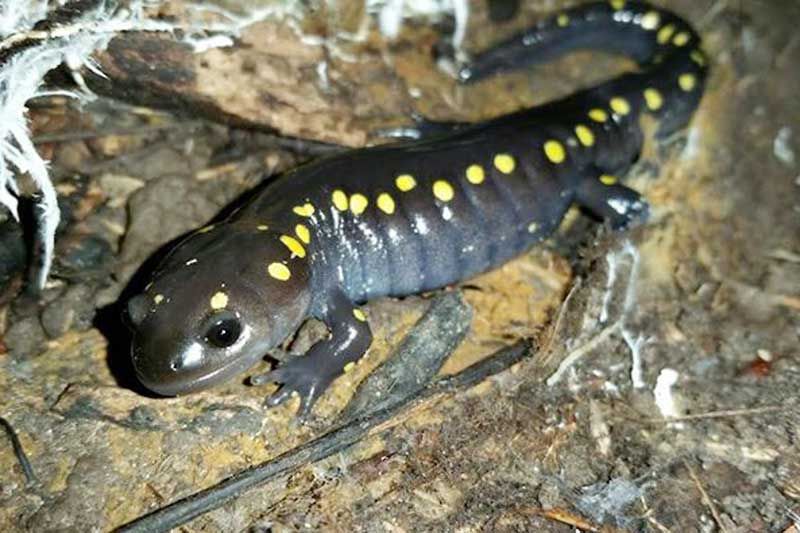Matt Ellerbeck | Sep 03, 2015
Most individuals who camp, hike, or cottage in the Frontenac area have encountered snakes, turtles, and frogs. But there is another group of reptiles and amphibians in the area. These are the salamanders, and seven different kinds of these animals occur within the Frontenac region. However, many people have never seen one of these amphibians due to the fact that salamanders spend much of their lives hidden (either underground or under natural debris in the humid locations of cool forests). They may only emerge on rainy nights, not the time that most people like to go hiking, and this is why so few people encounter salamanders.
As with frogs, many salamander populations are in decline; therefore to help contribute to a better understanding of their numbers, I have been out collecting observational records of salamanders. These are sent to the Global Amphibian BioBlitz, which is presented by the Smithsonian Conservation Biology Institute, the International Union for Conservation of Nature's Species Survival Commission, the Amphibian Specialist Group and the Amphibian Survival Alliance.
As such, I have had numerous opportunities to observe the salamanders that live within the Frontenac area. The most common species in most locations throughout the region is the Red-backed Salamander (Plethodon cinereus). These small, lung-less salamanders are very common in woodland areas. Aside from being prolific, these salamanders have extremely varied morphology in terms of colouration and pattern. The typical “red phased” individuals have a red dorsal stripe. This may be various shades of red, orange, or even yellow. Another colour phase exists in which no dorsal stripe is present and the salamanders are instead a uniform greyish-blue colour. Some even veer on purplish. These are known as Lead-backed Salamanders. Twice, I have had the extreme pleasure of observing rare leucistic (all white) forms. I have also seen a few predominately erythristic forms (all red).
Another species of small lungless salamander that I have observed frequently is the Four-Toed Salamander (Hemidactylium scutatum). These salamanders have a brownish to grey background colour, with white bellies speckled with black flecks. I usually encounter these salamanders in forests that are flush with various mosses, or in areas adjacent to bogs or forested ponds. The Committee on the Status of Endangered Wildlife in Canada (COSEWIC), considers the Four-toed Salamander to be rare, or at least rarely seen. This makes the numerous sightings that I have had of these salamanders that much more rewarding!
Another species of small salamander that is found in the area is the Eastern Newt (Notophthalmus viridescens). Most people encounter Eastern Newts during the Red Eft stage (terrestrial juvenile). At this point in their life cycle they are bright orange with red spots. Many of the Newts that I have seen were Efts, often in damp forested areas near wetlands or ponds. Most of the adult Newts that I have encountered were also on land, under cover close to water, although I have frequently encountered them in ponds and wetlands too.
The area is also home to several species of Mole Salamanders. Compared to the lungless forms and Newts, these salamanders seem like giants! One of the most commonly encountered of these is the Blue-Spotted Salamander (Ambystoma laterale). These salamanders have a dark background colouration covered with blue speckles. I have encountered Blue-Spotteds legions of times, usually under pieces of bark or fallen logs in cool forests. One campground I visited seemed to be teeming with them. I found them under door mats, tent covers, and in wood piles.
Another commonly encountered mole salamander is the Yellow-Spotted (Ambystoma maculatum). This is the largest terrestrial salamander in Ontario, growing up to 20-25 cm long. They have a dark background colouration with bright yellow “polka dots”. These are highly variable in term of the number and size of the spots. I have observed A. maculatum as much as A. laterale. Particularly, under cover (logs & rocks), next to forested ponds and wetlands.
The largest salamander species in Ontario is the Mudpuppy (Necturus maculosus). These amphibians can reach lengths of close to 20 inches! With large external gills they are adapted to a totally aquatic life. I have observed mudpuppies many times just outside of the Frontenac area. Only once have I seen one within the region. Their preference for cool water means they usually leave the shallows in the summer and again often only emerge from rocky crevices at night.
The Frontenac area is home to many interesting salamander species, all of which are helpful to people by either preying on insects, mosquito larva and ticks, or by keeping forests and wetlands healthy. It is important to bring attention to these species as several are in decline, and certainly, people will not be supportive of protecting and conserving animals that they aren't even aware of.
Learn how you can help salamanders at: www.savethesalamanders.com
More Stories
- September Closures for Northbrook And Sharbot Lake Beer Stores
- This "Doc Is Not In Anymore" After 54 Years
- Mazinaw Lake Swim Program Only Getting Stronger After 53 Years
- "Jack of Diamonds, Jack of Diamonds" but No Ace Of Spades Yet
- Sydenham Legion Presents ATV to Canada Day Raffle Winner
- Bathing in Blue Mindfulness: An Otter Lake Journey in Frontenac Park
- Central Frontenac Buys Used Pumper At Special Meeting
- 4th Annual Sharbot Lake Beach Bash
- Frontenac ATV Club Rallies For A Community Cause
- Harrowsmith Shadowdale Blooms: Kindness In Full Colour

